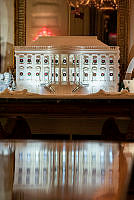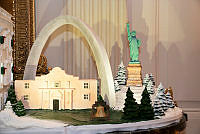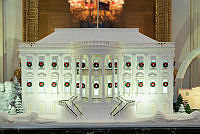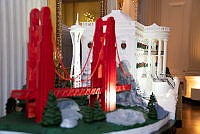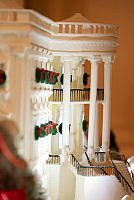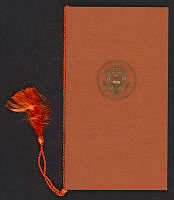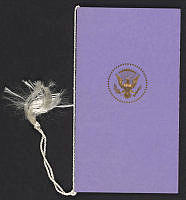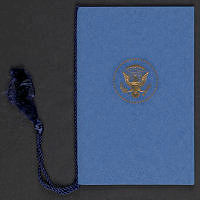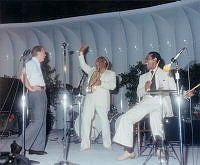Rubenstein Center Scholarship
Spanish Influenza in the President's Neighborhood
When Americans consider threats to democracy during President Woodrow Wilson’s administration, they usually think of the bloody world conflict that became World War I. As the war was ending in 1918, another often-forgotten adversary arrived in the United States: an outbreak of the Spanish influenza, a deadly pandemic which significantly impacted global populations, including Washington, D.C. Scientists estimate that the Spanish influenza infected one-third of the world’s population, and as the influenza spread, the President’s Neighborhood found itself in the middle of a deadly outbreak.1
“Spanish influenza” is something of a misnomer, as there is no evidence that the outbreak began in Spain. However, it became known as the Spanish flu due to the quantity of infection reports in the Iberian Peninsula—including the illness of Spanish King Alfonso XIII.2 The U.S., France, and other war-weary nations had similar rates of infection in their populations, but war censorship led reporters to underestimate the disease to protect morale. Meanwhile, Spain, a neutral country, reported deaths from the flu without hesitation.3 As a result, the outbreak was commonly referred to as the “Spanish influenza.”

Washington, D.C. public health officials attempted to warn citizens of the symptoms and spread of influenza using posters like this one.
Library of CongressThe virus originally flourished in the close quarters of the trenches and military encampments of World War I, and the international movement of soldiers facilitated infection across borders. By October 1918, the city of Washington, D.C. became a breeding ground for the highly contagious H1N1 strain of the flu. As civilian cases multiplied, local health officials initiated bans on public gatherings in order to quell the spread of infections. Across the city, public schools and universities closed their doors, and Congress and the Supreme Court adjourned.4 Meanwhile, emergency hospitals opened across the District as nurses desperately tried to care for the constant influx of patients. Influenza cases continued well into the next year, disproportionately affecting healthy residents in their mid-twenties and thirties, a group normally predisposed to fight infectious disease. The infection of the strong and youthful, in addition to babies and the elderly, caused life expectancy in the U.S. to drop by twelve years in 1918.5

Nurses care for the sick at Walter Reed Hospital in Washington, D.C. in 1918.
Library of CongressThis proximity to the outbreak meant that those working within the White House were vulnerable, and the Spanish influenza affected members of the Wilson family and staff. The first documented case of influenza within the administration was reported at the height of the pandemic in October 1918, when President Wilson wrote to Mississippi Senator John Sharp Williams, emphasizing “I would have answered your letter of October 14th sooner, had not my Secretary been absent with the influenza.”6 That same month, First Lady Edith Wilson responded to the outbreak by sending 1,000 roses to sick young women working for the war effort in Washington, “with an expression of sympathy and the hope of speedy recovery.”7
The pandemic did not only affect human patients. In January 1919, The Washington Post reported that two of the White House sheep, known for grazing on the White House Grounds and raising money for the war effort, were “in an animal hospital and…said to have influenza symptoms.”8 Fortunately, they made a speedy recovery under the care of the Department of Agriculture and returned to the lawn in less than two months.9

White House sheep grazing during the Wilson administration.
Library of CongressDespite the unprecedented scale and mortality rate of the Spanish influenza, an armistice remained the most critical matter for those working for the Wilson administration. After nearly four years of war, a ceasefire was reached in November 1918, but post-war peace was far from finished. The Paris Peace Conferences began in January 1919, where the “Big Four” (France, the U.S., the United Kingdom, and Italy) met to discuss peace in Europe and abroad for future generations.10 Travels to Paris for the negotiations further increased the risk of staff catching the disease, as cases in Europe persisted into 1919. In February, multiple members of Wilson’s staff caught the influenza during a transatlantic voyage from Brest, France, to Boston, Massachusetts, including several Secret Service members, Chief Usher Irwin “Ike” Hoover, and Charles Swem, Wilson’s stenographer.11 President Wilson’s eldest daughter, Margaret, also fell ill that month during a trip to Brussels and was “confined to her room in the American Legation.”12 They all recovered upon returning to the U.S.

President Woodrow Wilson is pictured above with Allied leaders, with whom he would negotiate during the Paris Peace Conference. Wilson fell ill at the conferences in spring 1919.
Library of CongressEven President Wilson could not avoid the contagious disease, and became ill in the midst of the peace talks. In April 1919, Rear Admiral Cary T. Grayson, personal physician to the president, wrote to a friend, explaining that: “These past two weeks have certainly been strenuous days for me. The President was suddenly taken violently sick with the influenza at a time when the whole of civilization seemed to be in the balance.”13 The extent of President Wilson’s illness was not revealed to the American people, however. Instead, Grayson informed the press that it was merely a cold caused by the “chilly and rainy weather” in Paris to maintain confidence in the president.14 Wilson’s absence came at a critical moment of the negotiations. The Big Four were attempting to solve larger questions of German reparations, the creation of the League of Nations, and the threat of Bolshevism—all of which were jeopardized by Wilson’s sickness.15 As Grayson’s assuring reports of Wilson’s speedy recovery were printed in The New York Times and The Washington Post, influenza confined Wilson to his bed, where he was barely able to talk or stand upright.16 The press reported his condition back to concerned American audiences daily. One columnist for The Washington Post wrote:
The country will be anxious regarding President Wilson until he is again at work…It is a time when an hour lost means the loss of millions of hours to these individuals who are awaiting to begin reconstruction…the allied world hopes for the sake of its material interests that his illness will be light and brief.17

President Woodrow Wilson walks with Rear Admiral Cary T. Grayson, his personal physician and close confidante.
Library of CongressBack at the White House, worried citizens expressed sympathy for their sick president abroad and well-wishers across America sent “scores of telegrams” to the Executive Mansion.18 To the country’s delight, Wilson recovered his strength and quickly returned to negotiations.
A promising American politician and future White House resident also caught the deadly virus and survived—Assistant Secretary of the Navy Franklin Roosevelt. In September 1918, The Washington Times reported that Roosevelt fell ill with Spanish influenza during a voyage to France.19 Aboard the U.S.S Leviathan, close to one-sixth of the men onboard became infected, claiming almost two thousand victims.20 Severely weakened, Roosevelt was carried off the ship on a stretcher after docking in America and transported via ambulance to his mother’s home in New York, where he made a full recovery.21

Washington Times report of Franklin Delano Roosevelt's illness in 1918.
Washington TimesIt is difficult to imagine the course of American history if Woodrow Wilson had succumbed to the disease during post-war peace negotiations or if Franklin Roosevelt had not survived the pandemic. Not all of their countrymen would be so lucky—over 675,000 Americans died during the unprecedented outbreak. Fortunately, by March 1919, cases had steadily decreased in the Washington, D.C. area, but by then, almost 35,000 residents of the District had contracted influenza in some form.22 Small spikes in infection, like President Wilson’s illness in April, continued until the pandemic ultimately abated globally by 1920.
These stories of the Spanish Influenza remain salient today, particularly following the global outbreak of the COVID-19 (Coronavirus) pandemic. The connections between 1918 and 2020 are a striking reminder that the present is never far removed from the past. As in 1918, 2020 witnessed the widespread closure of schools, strict mandates surrounding social gatherings and interactions between citizens, and American concerns about the health of leaders in the White House and abroad.














